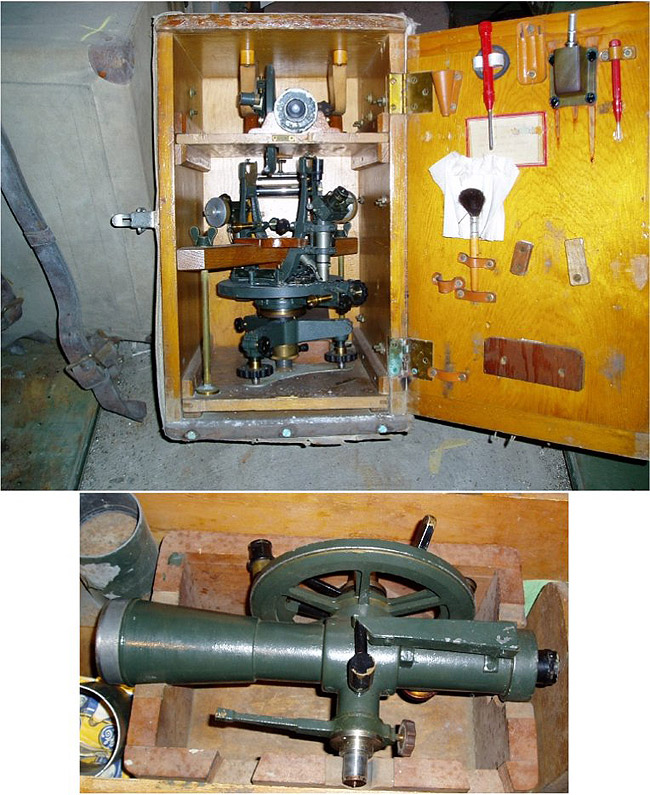 Thomas Jefferson's Theodolite
Thomas Jefferson's Theodolite Hassler's Camp
Hassler's Camp The Great Theodolite
The Great Theodolite Würdemann Six-inch Theodolite
Würdemann Six-inch Theodolite Heliotrope
Heliotrope Micrometer Scale
Micrometer Scale Theodolite Mounted on Water Tank
Theodolite Mounted on Water Tank Seven-inch Repeating Theodolite
Seven-inch Repeating Theodolite C&GS Twelve-inch Theodolite
C&GS Twelve-inch Theodolite Wild T-4
Wild T-4 K&E Theodolite, Parkhurst Design
K&E Theodolite, Parkhurst Design Wild T-2
Wild T-2 Wild T-3
Wild T-3 Topcon GPT-3002LW Total Station
Topcon GPT-3002LW Total Station
K&E Theodolite, Parkhurst Design
The nine-inch theodolite in this image was known as a "Parkhurst" theodolite, named after its designer. This instrument was much smaller than earlier theodolites and had several added features, such as an illumination system that allowed the theodolite to be used at night.

Another skilled member of the Coast Survey's instrument division was D.H. Parkhurst. As can be seen in earlier theodolites in this collection, the 12-inch theodolites may not have been the monsters in size of the 300-pound Great Theodolite, but they were still quite large.
Historic Reference
In 1927, Parkhurst, then Chief of the Instrument Division, introduced a design that not only scaled down the size of theodolites without loss of accuracy, but also addressed several other issues. The new design eliminated binding of the telescope caused by temperature changes, an ever-present problem with earlier theodolites. It also introduced a system of illumination powered by batteries set on the ground or on a platform under the instrument. Since most high accuracy observations were done at night, such illumination was particularly important. Parkhurt's new instrument served as the workhorse of the agency for many years.
The first Parkhurst theodolite was made by August Heim at the Coast and Geodetic Survey headquarters, but instruments of the design shown in the image were also made to order by surveying instrument manufacturers. Keuffel and Esser, generally known as "K&E," produced surveying instruments from 1876 until around 1969, including the theodolites of Parkhurst design shown in this image.
The Parkhurst theodolite weighed 35 pounds and the case added another 40 pounds. Despite this weight, the Parkhurst theodolite was a comparatively light-weight instrument. Having a horizontal circle of nine inches, it was 20 inches in height, with a 12-inch long telescope and a six-inch vertical circle.
In the top image, various tools used for cleaning and adjusting the theodolite are visible on the door of the case. In the top portion of the image, the telescope is packed so that the objective end is pointed directly at the viewer, which makes it hard to see. A Parkhurst telescope is better shown in the bottom image.
- Instrument Shown: K&E theodolite of Parkhurst design
- Location: Corbin, Virginia
- Manufacture Date: 1927
- Dates of Use: 1927 to 1952
- Photo Date: 2004
Works Consulted
Bowie, W. (1932). The Standard Theodolite of the U.S. Coast And Geodetic Survey. Civil Engineering.
Smithsonian Virtual Surveying Instrument Collection. Keuffel and Esser. Retrieved July 25, 2006, from: http://americanhistory.si.edu/collections/surveying/maker.cfm?makerid=17.
Smithsonian Virtual Surveying Instrument Collection. Theodolite. Retrieved August 21, 2006, from: http://americanhistory.si.edu/collections/surveying/object.cfm?recordnumber=758795.
